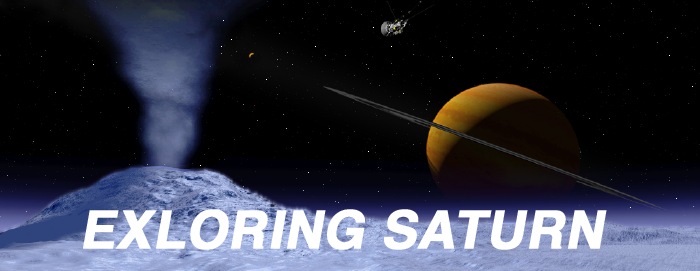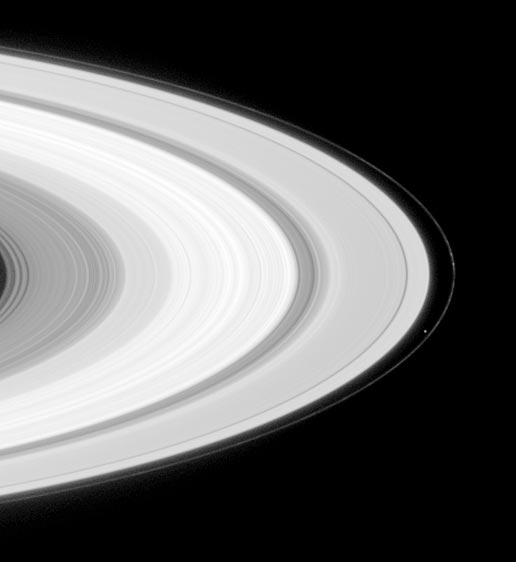 |
|||||||
| One of the Most Complex and Ambitious Ventures in the History of Space Exploration | |||||||
| Saturn | Rings | Moons | Titan | Cassini | Science | Huygens | Resources |
LATEST CASSINI NEWS FROM SATURN »» SOME CASSINI FINDINGS SO FAR »»
MOONS OF SATURN » RINGS OF SATURN » MOONS OF THE SOLAR SYSTEM »
Saturn is the second largest planet in our Solar System. It is the sixth planet outward from the Sun.
Saturn by Cassini
At a distance of some 900 million miles, Saturn is almost twice as far from the Sun as the planet Jupiter.
From Saturn, the Sun appears ten times smaller than it appears from Earth. An average area on Earth receives 90 times the amount more sunlight than the same area on Saturn.
Being farther from the Sun, Saturn is much colder than Jupiter, with an average temperature around –285°F.
Somewhat like our Solar System of which it is a part, Saturn has its own system, including spectacular rings and the second greatest collection of moons in the Solar System including the second largest moon in the Solar System.
The planet is named for the ancient Roman god of agriculture. The English word Saturday comes from the word Saturn.
Take a look. Saturn is seen easily without a telescope. In fact, people have being seeing Saturn in the nighttime sky since before history.Today, Saturn's rings and larger satellites can be seen with a small telescope. By the way, it's easy to identify Saturn as a planet because its light is steady. It doesn't twinkle like the stars.
- In 1610, the Italian astronomer Galileo was the first to observe Saturn with a telescope.
- In 1655, Dutch physicist Christiaan Huygens spotted the first moon of Saturn.
- In 1656, Huygens figured out the shape of the rings around Saturn. To honor his work, the Titan lander carried into the Saturn system by the Cassini spacecraft in 2004 was named for Huygens. The lander descended onto Titan in 2005.
Big ol' gas bag. Astronomers refer to four of the Solar System's outer planets as gas giants – Jupiter, Saturn, Uranus and Neptune.
Saturn, which formed more than four billion years ago, is mostly hydrogen and helium gases. There are lesser amounts of methane and ammonia. Saturn is a big ball of gas almost 75,000 miles in diameter held together by the pull of gravity. Hydrogen and helium also are the main gases in the Sun.
While almost as big in size as Jupiter, Saturn's mass is only 30 percent of Jupiter's mass. And its density is lowest in the Solar System. It's so low, in fact, that it would float in a bathtub if only we had a big enough tub.
Saturn doesn't have a solid surface of hard ground that we could walk on. What we see through telescopes is not a surface, but actually the top layer of a cloud of ammonia ice crystals.
Saturn's interior certainly is quite hot. The core temperature probably is 21,150°F. In fact, Saturn radiates more energy into space than it receives from the Sun.
Saturn's core may be rocky and about the size of the planet Earth. Above that hard core may be a liquid metallic hydrogen layer and a molecular hydrogen layer. Various ices also may be present.
Saturn looks yellow to us because it is reflecting light from the Sun. Small amounts of impurities within the ammonia cause the other colors we see in Saturn's cloud tops.
Winds are extreme at Saturn's equator where they can reach speeds greater than 1,100 mph. By comparison, the strongest hurricane winds on Earth reach 246 mph. Saturn's winds combine with heat from the planet's interior to spawn the yellow and gold bands we see in the planet's atmosphere.
The clouds tops are quite cold at around –400°F. Interestingly, the ammonia might be frozen and rain down from the clouds at –300°F..
The planet is surrounded by an enormous magnetic field. Like a huge bubble, this magnetosphere traps and holds electric particles near the planet.
The planet spins so fast, a day on Saturn lasts just over 10 hours. Because the planet is so far from the center of the Solar System, it takes Saturn almost 30 years to make a trip around the Sun.
The Moons. Saturn's moons are Titan, Rhea, Iapetus, Dione, Tethys, Enceladus, Mimas, Hyperion, Prometheus, Pandora, Phoebe, Janus, Epimetheus, Helene, Telesto, Calypso, Atlas, Pan, Ymir, Paaliaq, Siarnaq, Tarvos, Kiviuq, Ijiraq, Thrym, Skadi, Mundilfari, Erriapo, Albiorix, Suttung, and others yet to receive names.
list of saturn moons »
When the Cassini spacecraft from Earth arrived at Saturn in 2004, it promptly found two previously unseen moons. They turned out to be the smallest bodies seen around the ringed planet up to that time.
The tiny natural satellites are about 2 miles and 2.5 miles in diameter. That's smaller than the city of Boulder, Colorado. Previously, the smallest moons seen around Saturn were are about 12 miles across. The moons are 120,000 miles and 131,000 miles from the center of planet Saturn between the moons Mimas and Enceladus.
The newly discovered bodies were labeled S/2004 S1 and S/2004 S2. Later, they will be given names. The NASA JPL team wondered if S/2004 S1 might not be an object called S/1981 S14 that had turned up in a 1981 Voyager image.
Each of Saturn's known moons is unique. Here are some examples:
- Enceladus has a very bright surface and may have active water volcanoes.
- Tethys has a canyon running three-quarters of the way around its surface. It once may have split almost in half.
- Dione and Rhea have wispy white markings on one side.
- Mimas has an enormous crater — a hole caused by a meteorite. The moon may be responsible for the emptiness of the so-called Cassini division between rings.
- Hyperion is oddly shaped and the length of its day is constantly changing.
- Iapetus is half bright and half dark.
- Pan is a tiny moon only about 12 miles in diameter. It is between rings in the so-called Encke Division.
- Atlas, Prometheus and Pandora are shepherd moons because they keep rings in place.
- Titan is Saturn's largest moon. It's larger in diameter than the planet Mercury and larger and more massive than the planet Pluto. In fact, astronomers once listed Titan as the largest moon in the Solar System, but more precise measurements revealed that it has a very thick atmosphere around it and Jupiter's moon Ganymede has a larger solid surface. Titan was the prime target of the Cassini-Huygens mission.
The Rings. The big planet is known for its dramatic rings. People often refer to it when they say, "the ringed planet." Of course, some other planets have rings.
Saturn's rings by Cassini
Why are there rings around planets? It's not clear. Rings are not stable so they must rebuild themselves regularly. Saturn's current set of rings probably are only a few hundred million years old.
There are several rings around Saturn, each different from the others.
list of saturn rings »
Three rings known as A, B and C can be seen from Earth:The rings are not perfectly circular and the gaps between the rings are not entirely empty.
- The rings that astronomers have labeled A and B stand out, while another ring labeled C is faint.
- The gap between the A and B is referred to as the Cassini division.
- A faint gap in the outer part of A is known as the Encke Division, although German astronomer Johann Franz Encke may never have seen the gap.
Voyager saw spokes and braids in the rings. Cassini has seen spirals. These mysteries may relate to Saturn's magnetic field.
- If you were to take a close-up look at a ring, you would see a flood of pieces from inches to feet in size, each in an independent orbit. There might be some chunks as large as a mile or so across.
- You also would see the ring is very thin. While it may be 150,000 miles across, it might be only half a mile thick.
- There's really not much in the ring. While it appears expansive, compressing the ring's material would result in a clump only about 60 miles in diameter.
- The ring's particles probably are water ice with some small ice-covered rocks.
Four previously unknown, faint rings turned up in photographs sent back the Voyager spacecraft in the 1980s.
The outermost ring, labeled F, actually is several smaller rings with some knots of clumped material. Could the knots be tiny moons?
Saturn's rings were believed to be unique until 1977 when very faint rings were discovered around the planet Uranus. Shortly after that, other rings were seen around the planets Jupiter and Neptune.
Robot Explorers. Saturn has been visited by several interplanetary probes from Earth. The first was Pioneer 11 in 1979.
Later, Saturn was visited by twin spacecraft from Earth known as the Voyagers. In fact, most of what we knew about Saturn and its system of moons and rings for two decades was learned when Voyager 1 flew by Saturn in 1980 and when Voyager 2 flew by Saturn in 1981.
The robot explorers Cassini and Huygens arrived in the Saturn system on July 1, 2004. Huygens did its job in 2005 while Cassini will work among the moons and rings until at least 2008. Now we are learning a great deal more about the beautiful ringed planet.
LATEST NEWS FROM CASSINI »»
List of Moons and Rings. Here the natural satellites of Saturn and the rings around the planet:
Moons of Saturn NAME DISCOVERED Iapetus 1671 Rhea 1672 Tethys 1684 Dione 1684 Titan 1655 Mimas 1789 Enceladus 1789 Hyperion 1848 Phoebe 1898 Janus 1966 Atlas 1980 Prometheus 1980 Pandora 1980 Epimetheus 1980 Telesto 1980 Calypso 1980 Helene 1980 Pan 1990 Ymir 2000 Paaliaq 2000 Siarnaq 2000 Tarvos 2000 Kiviuq 2000 Ijiraq 2000 Thrym 2000 Skadi 2000 Mundilfari 2000 Erriapo 2000 Albiorix 2000 Suttung 2000 S/2003 S 1 2003 S/2004 S 1 2004 S/2004 S 2 2004
Rings of Saturn NAME
ring or gapDISTANCE
kilometersWIDTH
kilometersD Ring 63,500 11,000 Guerin Division C Ring 74,500 17,600 Maxwell Division 87,750 500 B Ring 92,100 25,300 Cassini Division 117,400 4,700 Huygens Gap 117,680 300-400 A Ring 122,100 14700 Encke Minima 127,500 3,500 Encke Division 133,500 Keeler Gap 136,500 F Ring 140,210 G Ring 165,800 8,000 E Ring 180,000 300,000
LIST OF ALL PLANETS AND THEIR MOONS »»
| Top of this page | Saturn main page | The Planet | The Rings | The Moons | Solar System |
| Cassini probe | Cassini Science | Titan moon | Huygens | Internet Resources | |
| STO Cover | Search STO | Questions | Copyright 2005 Space Today Online | ||

